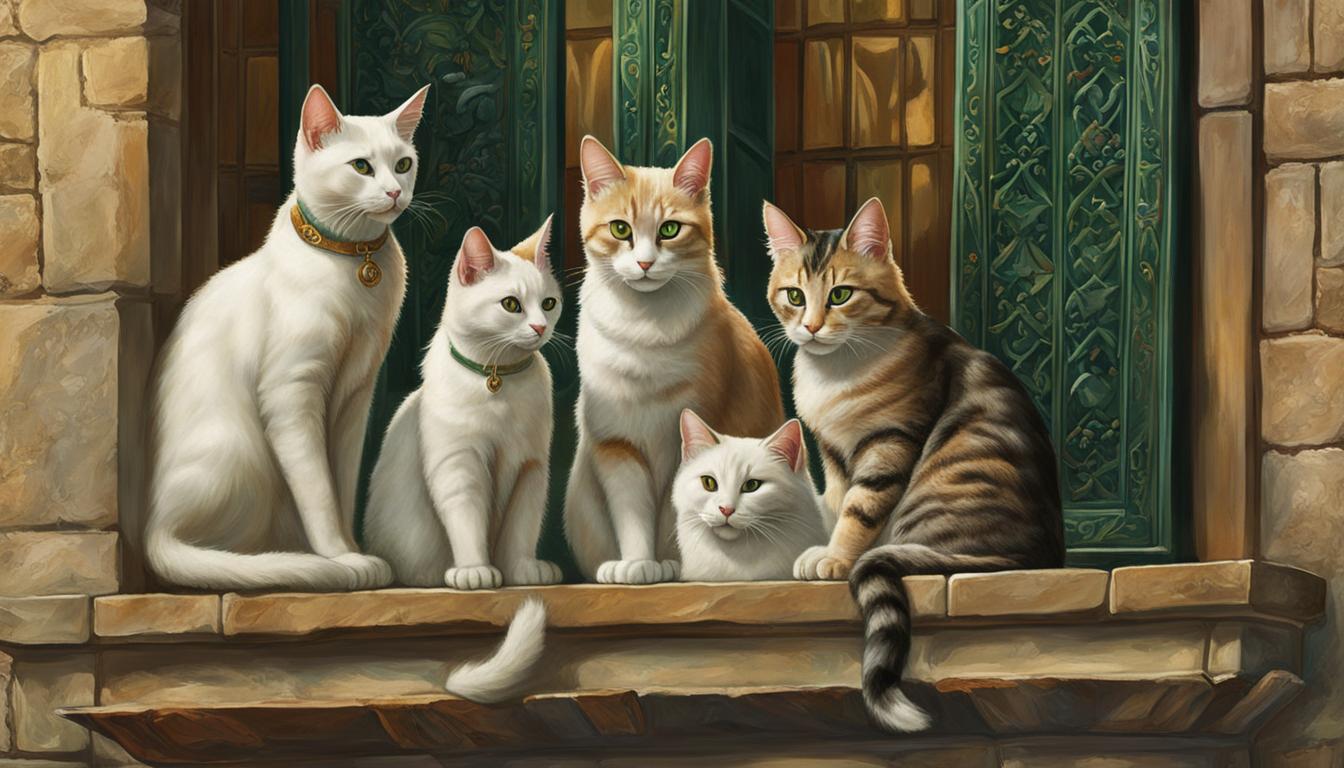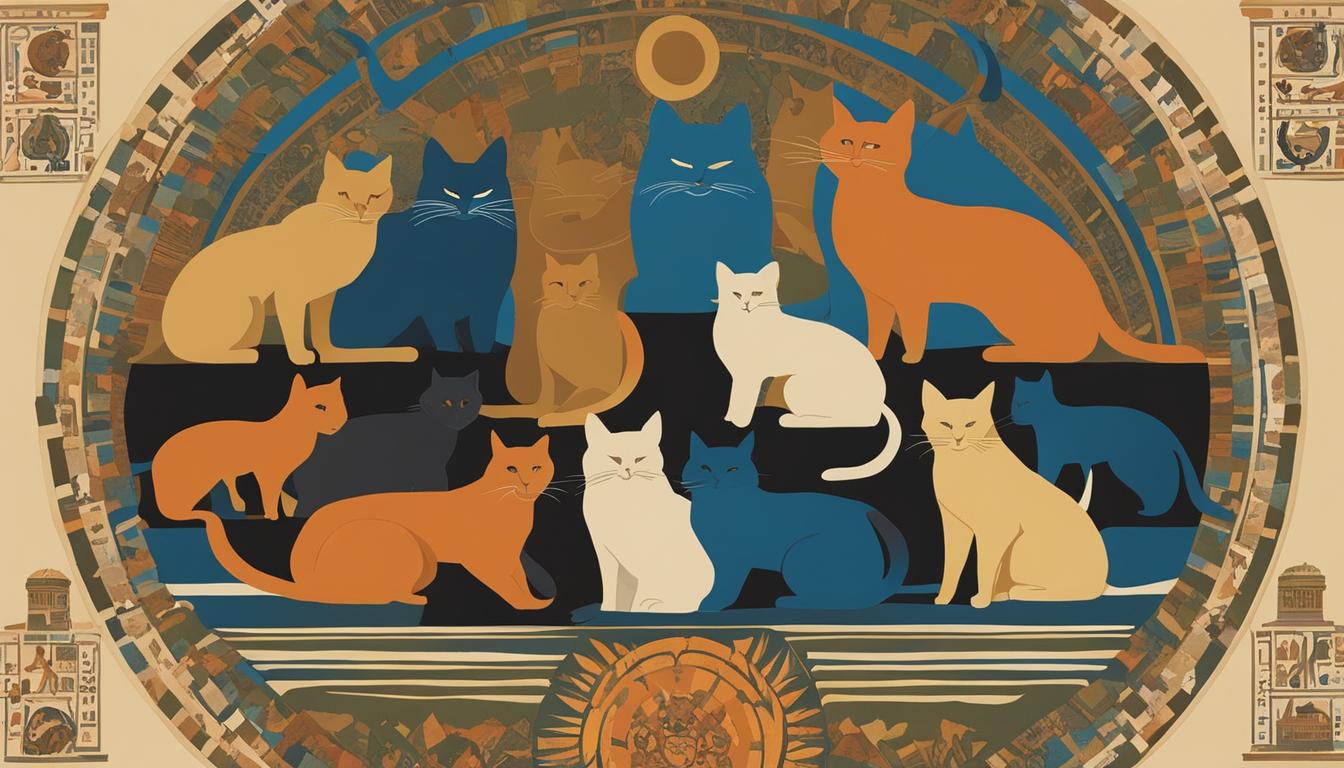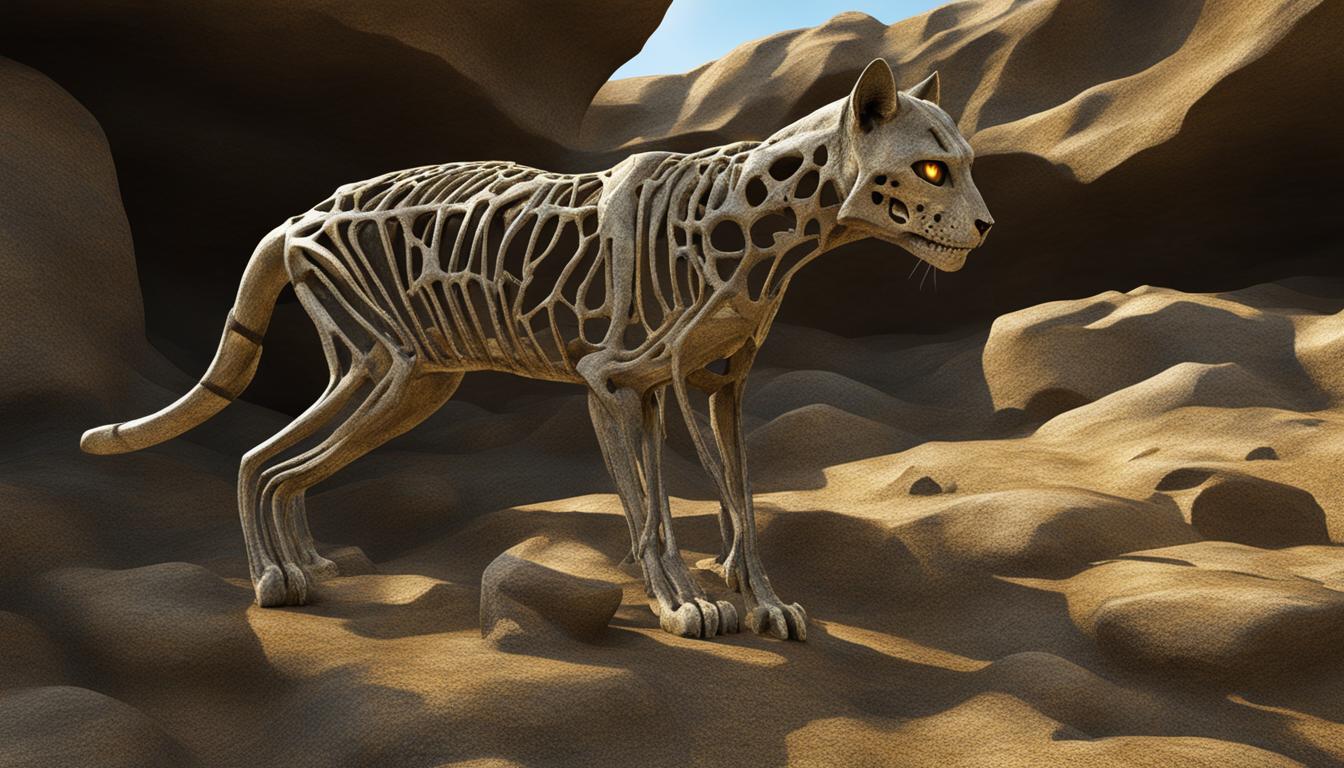Gather ’round, fellow feline enthusiasts! Today, I invite you to embark on a journey through the mysterious world of medieval cats. These enchanting creatures have long captivated our imaginations, but what secrets do they hold? Join me as we unravel the myths and superstitions that surround these furry companions of yore.
Ah, the Middle Ages, a time of knights, castles, and yes, cats. While black cats were once revered and adored in ancient cultures such as Egypt, medieval Europe took a dark turn when it comes to these bewitching creatures. Superstitions and misconceptions prevailed, leading to widespread persecution and fear.
Key Takeaways:
- Black cats were once symbols of protection and good luck in ancient cultures.
- In medieval Europe, black cats became associated with witchcraft and were persecuted.
- Superstitions surrounding black cats persist to this day.
- Cats played a practical role in medieval households, protecting food supplies from vermin.
- Medieval art and folklore often depicted cats, symbolizing their independence and mystery.
The Origins of the Black Cat Superstition
In ancient Egypt, black cats were revered as symbols of protection and good luck. Associated with the goddess Bastet, these feline companions were considered sacred and honored in Egyptian society. Sailors in medieval Europe also held a positive belief about black cats, believing that having one onboard their ships would ensure safe passage during their treacherous voyages.
However, the perception of black cats took a dark turn during the Middle Ages. As fear and paranoia surrounding witchcraft spread, black cats became associated with witchcraft and evil. The belief emerged that witches could transform into black cats and roam freely, aiding their sinister practices. This association between black cats and witchcraft led to the persecution and execution of countless innocent feline companions during the infamous witch hunts.
Despite the passage of time and societal progress, the superstition surrounding black cats persists in certain cultures. Crossing paths with a black cat on a dark night is still believed to bring misfortune and bad luck to this day. However, it’s essential to recognize that these superstitions are rooted in myth and legend, rather than reality.
“Black cats crossing your path signify that the animal is going somewhere.” – Groucho Marx
Interestingly, black cats have also made their mark in popular culture as symbols of mystery and intrigue. They have become iconic characters in literature, film, and television, adding to their allure and mystique. From Salem in “Sabrina the Teenage Witch” to Bagheera in “The Jungle Book,” these enchanting creatures continue to captivate us with their enigmatic presence.
To summarize, the origin of the black cat superstition can be traced back to ancient Egypt, where they were revered as symbols of protection and good luck. However, during the Middle Ages, black cats became associated with witchcraft, leading to their persecution and execution. While the superstitions surrounding black cats still persist today, it’s important to debunk these myths and appreciate the magic and beauty of these captivating creatures.
The Dark Turn: Black Cats and Witchcraft
During the Middle Ages, black cats became emblematic of the dark arts, as a pervasive fear of witchcraft swept through Europe. It was believed that witches could transform into black cats and roam freely under the cover of darkness to carry out their nefarious deeds. This association between black cats and witchcraft led to the persecution and execution of countless innocent feline companions during the infamous witch hunts.
The belief in witches’ ability to shape-shift into black cats stemmed from a prevailing belief in the supernatural. People during this time period were deeply superstitious and feared anything they couldn’t explain. Black cats, with their sleek and mysterious appearance, became scapegoats for inexplicable occurrences and were therefore demonized.
“The black cat is a symbol of witchcraft. It was said that witches could transform into black cats and lurk in the shadows, invisible to their enemies.” – Medieval folklore
The witch hunts of the Middle Ages were fueled by these superstitions and fears. Cats, especially black ones, were targeted as accomplices of witches and were often tortured and killed alongside their human counterparts. Accusations of witchcraft were based on flimsy evidence, and many innocent lives, both human and feline, were lost during this dark period in history.
Despite the passage of time and the spread of knowledge, superstitions surrounding black cats and witchcraft still persist today. Many people continue to view these beautiful creatures with suspicion and fear, often associating them with bad luck or misfortune. However, it is crucial to remember that these beliefs are rooted in unfounded myths and legends, rather than reality.
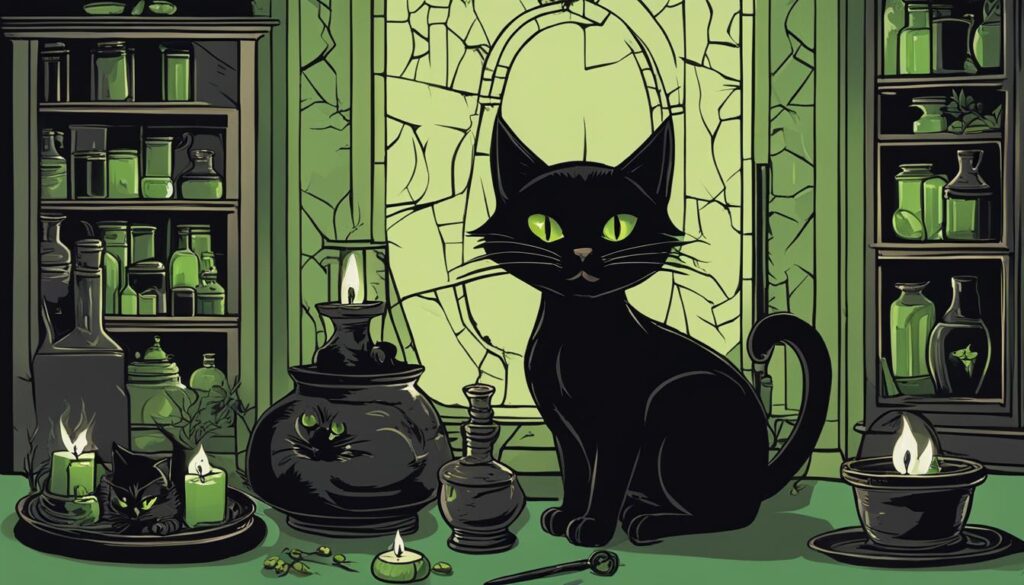
Historical Context and Cultural Influence
The widespread fear of black cats during the Middle Ages was influenced by a complex web of religious, cultural, and social factors. The Christian Church, in particular, played a significant role in promoting the association between black cats and witchcraft. The Church viewed witchcraft as heresy and actively propagated the notion that witches could transform into black cats to carry out their evil deeds.
Additionally, the social and economic upheaval of the Middle Ages created an environment of heightened anxiety and suspicion. As people grappled with social unrest, religious conflicts, and the devastating effects of the Black Death, they sought scapegoats for their woes. Black cats, with their perceived connections to the supernatural, became convenient targets for blame and persecution.
Today, while we may no longer believe in the magical abilities of black cats or their association with witchcraft, their mysterious allure continues to captivate us. From literature to film and art, black cats often symbolize mystery, intrigue, and a touch of the supernatural. They remind us of a bygone era when superstitions reigned and the line between myth and reality was blurred.
The Legacy of Black Cats in Modern Culture
Although the stigma surrounding black cats persists, many people are beginning to recognize the unfair treatment these creatures have endured throughout history. Animal welfare organizations and cat lovers worldwide are actively working to dispel the negative stereotypes associated with black cats and promote their adoption and well-being.
Black cats are not harbingers of bad luck, but rather fascinating creatures with a rich cultural history. It is time to appreciate their beauty and acknowledge the resilience they have shown in the face of unwarranted prejudice. This Halloween season, let us celebrate black cats for what they truly are – enchanting companions who deserve our love and admiration.
Modern Superstitions and Pop Culture
When it comes to superstitions, black cats have had a long-standing reputation as bringers of bad luck. Crossing paths with one on a dark night is believed to result in misfortune. However, it’s important to recognize that these beliefs are rooted in myth and legend, rather than any factual evidence. Despite advancements in society, some cultures still hold onto these superstitions, perpetuating the idea that black cats are harbingers of doom.
But there’s another side to black cats that often goes unnoticed – their role in pop culture. These enchanting feline companions have captured the imagination of authors, filmmakers, and artists, becoming symbols of mystery and intrigue. From literature to film to television, black cats have made their mark, becoming beloved characters in their own right.
One iconic example of a black cat in pop culture is Salem Saberhagen from the television series “Sabrina the Teenage Witch”. Salem, who is actually a warlock sentenced to live as a cat, adds a comedic and mischievous element to the show. Another well-known black cat is Bagheera from Rudyard Kipling’s “The Jungle Book”. Wise, loyal, and protective, Bagheera serves as Mowgli’s mentor and guide throughout his adventures.
| Famous Black Cats in Pop Culture | Medium |
|---|---|
| Salem Saberhagen | Television (Sabrina the Teenage Witch) |
| Bagheera | Literature (The Jungle Book) |
| Luna Lovegood’s cat, Crookshanks | Literature (Harry Potter series) |
| Church | Film (Pet Sematary) |
But it’s not just fictional black cats that have captured our attention. In the world of music, the song “Black Cat” by Janet Jackson became a hit in the late 1980s, showcasing the allure and mystery associated with these captivating creatures. Additionally, black cats have become a popular motif in tattoo art, representing independence, mystery, and the power of transformation.
So, while some still hold onto superstitious beliefs about black cats, it’s important to remember that they have a rich and vibrant presence in popular culture. These enchanting feline companions have inspired and entertained us for centuries, and it’s time to embrace their magic rather than fear it.
The Role of Cats in Medieval Households
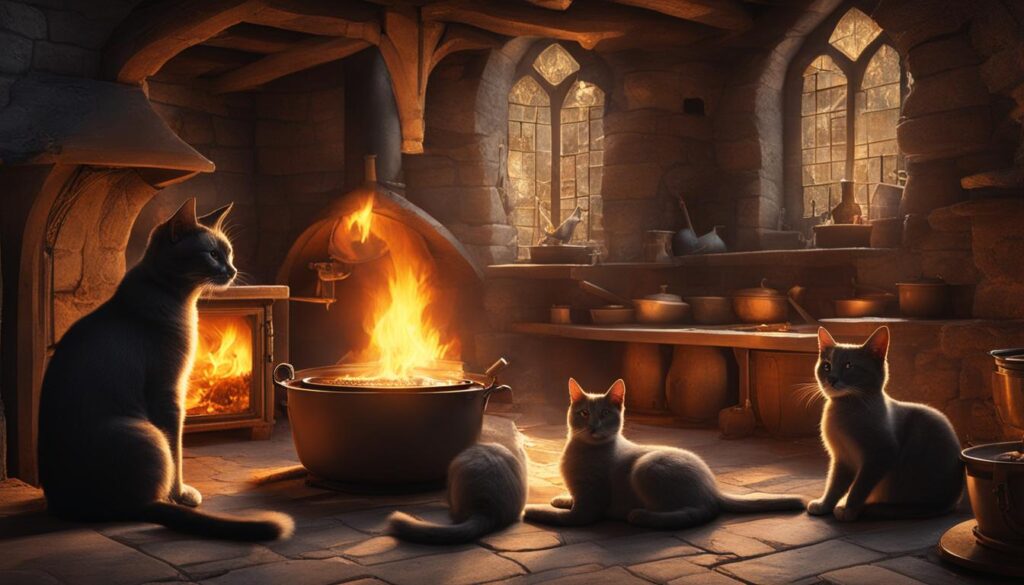
Cats played a vital role in medieval households, serving as invaluable companions and protectors. In both rural and urban settings, these furry feline creatures were cherished for their exceptional ability to control vermin, safeguarding precious food supplies from rodents and pests. Their presence brought immense practical benefits to medieval households, ensuring the preservation of essential resources.
Medieval people saw cats as essential members of their households, valuing their hunting prowess and innate agility. They were seen as mystical creatures that possessed the power to ward off evil spirits and bring good luck. Their independent and self-reliant nature also resonated with the medieval mindset, earning them a place in folklore and superstitions.
Cats and their Social Impact
Cats not only provided practical assistance but also had a significant social impact on medieval households. They were cherished as beloved pets and companions, bringing joy and comfort to individuals and families. The presence of a cat in the household created a sense of warmth and coziness, fostering a sense of belonging and emotional well-being.
The relationship between medieval humans and their feline companions was one of mutual respect and admiration. Cats were seen as loyal and faithful protectors, going beyond their duties as skilled hunters. They formed deep bonds with their human counterparts, offering companionship and solace during challenging times.
| Role of Cats in Medieval Households | Benefits |
|---|---|
| Vermin control | Protection of food supplies |
| Symbol of good luck | Ward off evil spirits |
| Companionship | Social and emotional well-being |
Overall, cats played an integral role in medieval households, offering practical assistance, emotional support, and a touch of mystique. They were valued for their ability to control vermin, protect food supplies, and create a sense of warmth and companionship. The bond between humans and cats in the medieval era illustrates the enduring connection between our species and these enchanting creatures.
Cats in Medieval Art and Folklore
Medieval art provides a fascinating window into the world of cats and their significance during that time. From religious manuscripts to tapestries and paintings, cats were a common subject in various art forms, symbolizing a range of qualities and capturing the imagination of artists and viewers alike.
Cats in Religious Art
In religious art, cats were often depicted as companions to saints and holy figures. They were portrayed as creatures of mystery and independence, embodying qualities that resonated with the spiritual realm. Cats were seen as guardians of knowledge and wisdom, their enigmatic nature reflecting the mysteries of faith.
One famous example of cats in religious art is the “Madonna of the Cat” painted by Italian Renaissance artist Pisanello. In this painting, the Virgin Mary is depicted holding the baby Jesus, while a cat playfully interacts with them. The cat’s presence suggests a sense of domestic tranquility and the harmonious coexistence of humans and animals in the divine realm.
Cats in Secular Art
Beyond religious art, cats were also celebrated in secular works, often as symbols of cunning and mystery. Artists recognized their agility and hunting prowess, and cats frequently appeared in scenes depicting everyday life in both rural and urban settings. These depictions showcased the practical role cats played in medieval households, as well as their ability to charm and captivate viewers.
An example of cats in secular art is the famous tapestry series known as “The Lady and the Unicorn.” In one of the tapestries, a cat is shown seated at the feet of the lady, symbolizing her independence and sensuality. The cat’s presence adds an air of intrigue and allure to the scene, underscoring its significance in medieval folklore and art.
Cats in Folklore
In medieval folklore, cats were associated with magical abilities and connections to otherworldly realms. They were believed to possess supernatural powers, such as the ability to see in the dark and communicate with spirits. These beliefs gave rise to numerous legends and tales featuring cats as enchanting creatures with a touch of the mystical.
One such folklore is the story of the “King of the Cats,” a feline ruler who commanded an army of cats and was said to make appearances during significant events. This legend served as a reminder of the unique place cats held in the medieval imagination, as both ordinary companions and creatures with a hint of the extraordinary.
| Art Form | Symbolism |
|---|---|
| Religious Art | Guardianship, mystery, wisdom |
| Secular Art | Cunning, captivation, practicality |
| Folklore | Magical abilities, connection to the supernatural |
Through their portrayal in art and folklore, cats in medieval Europe captured the imagination of the people and left a lasting legacy. Whether they were seen as symbols of religious significance, everyday companions, or mystical creatures, cats played a multifaceted role in shaping the medieval world’s cultural landscape.

Conclusion
As I unravel the fascinating history of black cats and their connection to superstitions, it becomes clear that these mystical creatures have endured a long journey filled with myths and misconceptions. Despite being associated with bad luck, black cats are more than just symbols of superstition; they are enchanting companions with a rich medieval heritage.
It’s important to remember that superstitions are rooted in myth and legend, not reality. Crossing paths with a black cat on a dark night may not bring misfortune, but rather a chance encounter with a beautiful and mysterious creature.
Throughout medieval Europe, black cats faced persecution during the witch hunts, where they were wrongly accused of being witches’ familiars. Today, it’s time to debunk these myths and embrace the magic of black cats. They have a significant place in our history, both in superstitions and in their invaluable role in controlling vermin and protecting households.
This Halloween season, let us celebrate black cats for the captivating companions they truly are. It’s time to break free from the chains of superstitions and appreciate the beauty, grace, and companionship that black cats bring into our lives.
FAQ
What were black cats revered for in ancient Egypt?
Black cats were honored as symbols of protection and good luck due to the goddess Bastet.
Why were black cats associated with witchcraft in medieval Europe?
During the Middle Ages, it was believed that witches could transform into black cats and roam freely to do their dark bidding.
Were black cats persecuted during the witch hunts?
Yes, the association between black cats and witchcraft led to the persecution and execution of countless innocent feline companions during the witch hunts.
Are black cats still seen as omens of bad luck?
Yes, some cultures still view black cats as omens of bad luck, although these superstitions are rooted in myth and legend.
What role did cats play in medieval households?
Cats were valued for their ability to control vermin and protect food supplies in medieval households.
Why were cats depicted in medieval art and folklore?
Cats were often depicted in medieval art to symbolize qualities such as independence, cunning, and mystery. They also featured prominently in folklore, with tales attributing them with magical abilities and connections to otherworldly realms.

